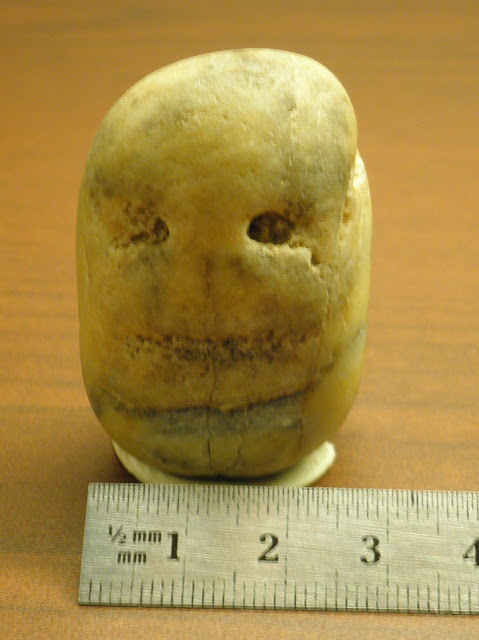Greg Martin family find from shore of Columbia River, Kennewick, Washington
Mr. Johnston;
I came across your blog when I was searching for information
on small rock carvings. I was looking
for information that might relate to a suspected face carved on a small stone,
found by my daughter’s boyfriend, along the Columbia River, in Columbia Park,
near Kennewick, WA in mid-March. It is
possible that the features are simply a natural occurrence, but to me the
configuration seems to imply some manipulation.
The stone is about 4.5 cm tall by 3 cm wide and 2.5 cm thick
(at thickest point). It appears to be
water worn as are most of the gravels found along the river and in the
region. As with much of the water worn
gravels found in this region, it is possible that it was transported here
during one of the many cataclysmic Missoula Floods which swept through western
Washington and along the Columbia River channel following the last ice age.
I have included four different views of the stone and would
be interested in your interpretation and comments, as well as any from readers
of your blog. Thank you for considering
my submittal.
Sincerely,
Greg Martin, Kennewick, WA
-----------
Hi Greg,
I think your intuition is correct about the manipulation of
this piece. It seems from the photo the
left eye could have a part of the natural stone and the right eye, the nose
line and the mouth were added. There is a known motif of "one eye open,
one eye closed or missing" in paleoart, so it may be in line with that.
Usually the left eye is closed or missing and in your case the hole, or missing
eye, is at left side of the face. The faces are usually in a moaning or mouth
agape position, so yours is unusual in that it appears content or slightly
smiling. I will be happy to post it soon
on my blog. I don't get as many comments
as I'd like, but I will solicit them on your behalf.
A man named Dennis Boggs from Irrigon, Oregon, I think 40
miles or so downriver from you, sent me his 50 year collection of "stones
that looked manipulated" and I have identified a number of "face
stones." You can do a site search of
"boggs" and see the list of postings.
Others in Washington and Oregon have also identified similar
material. Your daughter's boyfriend (or
you) should return to that same location and look for more possible worked
stones with figures because there are almost always more where one is
found. You can look at my postings to
see some of what may be possible out there. This would at least help you
assemble a "cluster of surface finds" and developing context information
is so important in archaeology. There is
no way to tell without more pieces and a real archaeology effort to determine
if they (assuming you find more) are in a place of original deposition or if
they have been aggregated by natural processes. I think people are finding them
in both situations.
I note you are a scientist and my position is that science
needs to be brought to bear on these kinds of anomalous finds. However, I think you might find
archaeologists are not too keen on the topic of intended imagery in crude
pebbles. I have been diagnosed with pareidolia by so many archaeologists, you'd
think they were licensed to practice psychology! It would seem that microscopic evaluation by
a competent specialist could determine or rule out human agency on the hundreds
of finds being identified by laypersons, even with taxonomies coming to light
because of the internet, but archaeology does not have a healthy mechanism to
evaluate anomalies- it is not a real scientific enterprise but seems to be a
group of gatekeepers who have vested interests in maintaining the status quo.
Thanks for taking time to write and for your photos.
Ken
------
Ken;
Thank you for your swift reply to my inquiry. I will take
your advice and return to the area where the stone was found and see if there
are any other examples of manipulated material.
The stone was found on the river shore in a highly trafficked area of
the Park, actually not that far from where the bones of ‘Kennewick Man’ were
found.
One of my hobbies is
tumbling stones (usually river rock). My
grandkids like the shinny rocks and it stimulates them to ask questions about
geology. After handling thousands of
local river or water worn rocks over the last few years, I have never come
across any with the sort of features which appeared to be human manipulated/created.
You can be assured that I will be doing my future collecting with a much more
critical eye.
Thanks again for your
response.
Greg --
Does anyone have comments or advice for Greg, or similar finds to this one?
-kbj










 "
"



















